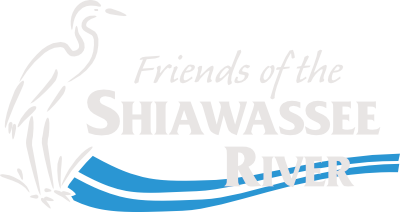DAMS: QUESTIONS & ANSWERS
Q: DOES THE SHIAWASSEE RIVER NEED DAMS TO MAINTAIN GOOD OXYGEN LEVELS IN THE WATER?
Consider this excerpt from an online article by The Scientific American: “According to the Hydropower Reform Coalition (HRC), a consortium of 150 groups concerned about the impact of dams, degraded water quality is one of the chief concerns. Organic materials from within and outside the river that would normally wash downstream get built up behind dams and start to consume a large amount of oxygen as they decompose. In some cases this triggers algae blooms which, in turn, create oxygen-starved “dead zones” incapable of supporting river life of any kind. Also, water temperatures in dam reservoirs can differ greatly between the surface and depths, further complicating survival for marine life evolved to handle natural temperature cycling. And when dam operators release oxygen-deprived water with unnatural temperatures into the river below, they harm downstream environments as well.” While there are no longer reservoirs behind the Owosso and Corunna dams, there is no benefit of oxygenation to the Shiawassee River.
Q: WHEN A DAM IS REMOVED, WHAT HAPPENS TO ALL OF THE GREAT FISHING HOLES?
A: Once a dam is removed, the river will carve a new path that may alter the river bottom and change the location of your favorite fishing holes. However, new fishing holes will be formed. It’s up to you to find them! A more natural, unobstructed waterway will only help existing fish populations to flourish, creating better fishing than ever.
Q: DOES DAM REMOVAL RESULT IN A MUDDY FLAT WITH STRANDED FISH AND ONLY A NARROW STREAM IN PLACE OF A BEAUTIFUL RIVER?
A: The answer to this question is “No,” but the explanation is twofold. After a dam is drawn down or removed, the previously impounded water behind the dam drains freely and the river regains its natural flow. The result is that water levels along the shore will recede, leaving unattractive, muddy shoreline behind. Additionally, the river bottom will be shallower in an area that was previously impounded, due to the previous lack of water flow and buildup of sedimentation. While it may appear unattractive, the muddy shoreline of the previously impounded area will soon grow vegetation and turn into a riparian area (a buffer between land and the river, which is an excellent habitat for wildlife). As the river continues to flow and carve a new path, the river bottom will also increase in depth. And no, fish do not become stranded in the mud unless the dam is drained suddenly, which also can happen if an aging dam fails. Click here to view a great video that shows the progression of river restoration.
Q: IF THE OWOSSO & CORUNNA DAMS ARE EVER REMOVED, WILL THE SHIAWASSEE RIVER DRY UP IN THE SUMMER MONTHS?
A: No. The Owosso and Corunna dams have little effect on the total amount of water that flows down the river. Rather, they reduce the flow of water. Factors that determine the amount of water flowing down the Shiawassee River include surface water runoff from land and cities adjacent to the river, seasonal rainfall, and the amount of water flowing from tributaries into the Shiawassee River.
Q: I HEARD THAT THE SHIAWASSEE RIVER WAS REFERRED TO AS THE SHIAWASSEE STREAM BEFORE THE DAMS WERE PUT IN PLACE IN THE EARLY 1900S. DOES THAT MEAN THAT IF THE OWOSSO AND CORUNNA DAMS ARE REMOVED, THE RIVER WILL TURN INTO A MERE STREAM?
A: This is not a factual statement. The Shiawassee River has always been known as a river, both before and after the installation of dams. It will remain a river, even if the dams are removed.
Q: HOW WILL DAM REMOVAL ON THE SHIAWASSEE RIVER HELP CURRENT POPULATIONS OF FISH, WHILE ENCOURAGING NEW SPECIES TO FLOURISH?
A: Dams are a barrier to fish migration and can adversely affect the number and diversity of current fish populations. Additionally, slow-moving or ponded water behind dams warms in the sun, which leads to decaying material and excessive vegetation growth behind the dams. In turn, this causes oxygen levels in the water to drop significantly, degrading habitat quality for fish and other aquatic inhabitants. Have you ever observed green, warm-weather growth on top of the water behind a dam? It is an example of excessive vegetation. Dam removal permits fish to migrate throughout a river; results in better water flow; improves flushing of sediment (which is of special concern in the Shiawassee River); reduces nutrient loadings and improves conditions for tiny aquatic organisms that are critical to the food chain.
Q: WHAT ARE LOW-HEAD DAMS, AND WHY ARE THEY UNSAFE?
A: Low-head dams, like those found in Owosso and Corunna, can range in size from a few inches to several feet high. They often are thought of as harmless, and may also be considered attractive due to their appearance and sound. However, low-head dams can be dangerous. A person or object that goes over a low-head dam can become caught in a strong hydraulic backwash that traps and recirculates anything that floats. Here is a video that demonstrates the phenomenon. As explained by Virgil Chambers, Executive Director of the Safe Boating Council, “Dams do not need to have a deep drop to create a dangerous backwash. During periods of high water and heavy rains, the backwash current problems get worse…Small low-head dams that may have provided a refreshing wading spot at low water can become a brutal death trap when river levels are up.” Click here to read an article about the dangers of low-head dams. The low-head dams in Owosso and Corunna currently serve no purpose. The Corunna dam will continue to be a potential danger until it is removed. In 2008, an experienced kayaker died after being caught in hydraulic backwash at the Corunna dam.
Q: WHAT ARE THE CURRENT PURPOSES OF THE OWOSSO LOW-HEAD DAMS?
A: Currently, the Owosso low-head dams, also known as weirs, serve no function or purpose. The three low-head dams are located near Main Street, Chipman Road, and Memorial Healthcare. They were constructed in the early 1930’s after a draught in 1931 produced record-low water levels. This also occurred at a time when city sewage was being flushed directly into the Shiawassee River. The low water levels resulted in sewage not flowing downstream as quickly as desired by residents, which created a foul odor in the air. The low-head dams were constructed with the intention to periodically flush the river by withholding and releasing water. To achieve this, the low-head dams had boards that ran one foot across the top and were installed seasonally, to help raise the water levels as needed. The boards have not been in place for many years. Now, water simply runs over the low-head dams, which are unnatural barriers in the river.
Q: WHAT IS THE CURRENT PURPOSE OF THE CORUNNA DAM?
A: The Corunna low-head dam currently serves no function or purpose. The dam was constructed in the mid 1800’s to supply water power for a grist mill. The mill was in operation for approximately 100 years, until it burned in the 1950’s. Since then, the dam’s structure has degraded and it has been deemed a significant safety hazard.
Q: WHAT WAS THE HISTORIC PURPOSE OF THE FORMER SHIATOWN DAM?
A: The Shiatown dam was first constructed in 1840, but later replaced with a hydroelectric dam in 1904. In the 1970’s, the dam and surrounding property was sold to Shiawassee County for use as a county park. Subsequently, the county sold the dam as property to a hydroelectric power company. Several companies tried but failed to find an economically feasible use for the dam. In 1999, the dam reverted to the State of Michigan due to unpaid property taxes. The state of Michigan initiated phase I of the Shiatown dam-removal process began in 2012, to remove the hazardous dam and restore that portion of the river to its natural state. Phase II of the dam-removal process will resume summer 2015.

